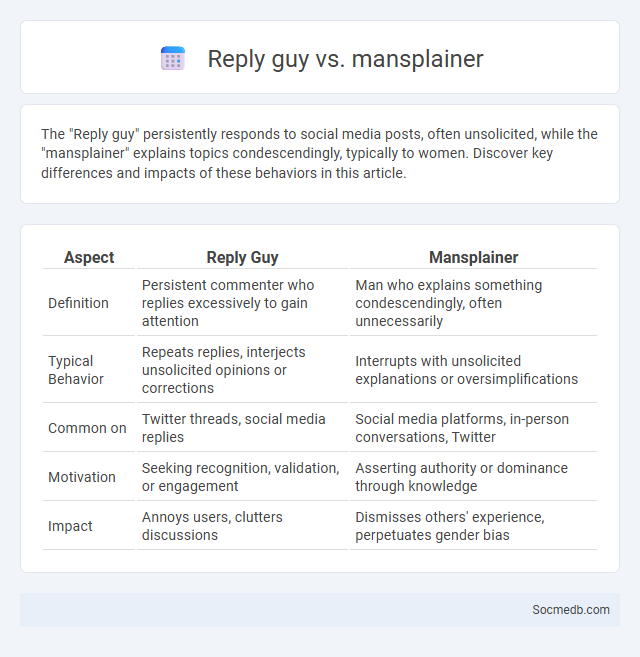
Photo illustration: Reply guy vs mansplainer
The "Reply guy" persistently responds to social media posts, often unsolicited, while the "mansplainer" explains topics condescendingly, typically to women. Discover key differences and impacts of these behaviors in this article.
Table of Comparison
| Aspect | Reply Guy | Mansplainer |
|---|---|---|
| Definition | Persistent commenter who replies excessively to gain attention | Man who explains something condescendingly, often unnecessarily |
| Typical Behavior | Repeats replies, interjects unsolicited opinions or corrections | Interrupts with unsolicited explanations or oversimplifications |
| Common on | Twitter threads, social media replies | Social media platforms, in-person conversations, Twitter |
| Motivation | Seeking recognition, validation, or engagement | Asserting authority or dominance through knowledge |
| Impact | Annoys users, clutters discussions | Dismisses others' experience, perpetuates gender bias |
Understanding the “Reply Guy” Phenomenon
The "Reply Guy" phenomenon on social media occurs when individuals habitually respond to posts, often offering unsolicited advice or commentary, sometimes overshadowing the original content. This behavior can impact online interactions, influencing the dynamics of discussions and user engagement. Understanding these patterns helps you navigate social platforms more effectively, fostering healthier communication and community building.
Who is the “Mansplainer”?
The "Mansplainer" is typically a man who explains something, often to a woman, in a condescending or patronizing manner, assuming she lacks knowledge on the topic. This behavior frequently appears on social media platforms where gender dynamics influence online interactions. Understanding your experience with mansplaining can help you recognize and address these dismissive communication patterns effectively.
Key Differences: Reply Guy vs. Mansplainer
Reply Guys frequently engage in social media by offering unsolicited comments or corrections, often seeking attention, while Mansplainers specifically explain topics condescendingly, assuming ignorance on the part of their audience. Your experience on platforms like Twitter or Instagram may highlight that Reply Guys crowd conversations with repetitive replies, whereas Mansplainers undermine others by dismissing their expertise through patronizing explanations. Both behaviors disrupt online dialogue, but the key difference lies in the Reply Guy's general intrusiveness versus the Mansplainer's targeted condescension.
Common Traits and Behaviors
Social media platforms share common traits such as user-generated content, real-time interaction, and algorithm-driven feeds tailored to individual preferences. Users often exhibit behaviors like content sharing, commenting, and networking to build digital communities and express personal identity. Understanding these patterns helps you navigate online spaces effectively and engage meaningfully.
Social Media and the Rise of Reply Guys
Social media platforms have amplified the visibility of "reply guys," users who frequently respond to posts, often seeking attention or validation. Their behavior impacts online conversations by cluttering comment sections with repetitive or unsolicited replies that can derail meaningful discussions. Understanding this dynamic is essential for managing digital interactions and fostering healthier social media environments.
Recognizing Mansplaining in Conversations
Recognizing mansplaining in conversations involves identifying when someone, often a man, explains something in a condescending or patronizing manner, assuming you lack knowledge. Your awareness of such behavior helps maintain respectful and balanced social media interactions by calling out and addressing these subtle forms of domination. Understanding this dynamic fosters more equitable communication, enhancing your online experience.
Impacts on Online Discussions
Social media platforms significantly shape online discussions by amplifying diverse voices and enabling real-time interaction across global communities. Your perspectives can reach wide audiences quickly, influencing public opinion and fostering collaborative problem-solving. However, echo chambers and misinformation often emerge, challenging the quality and reliability of digital conversations.
How to Respond to Reply Guys and Mansplainers
When dealing with reply guys and mansplainers on social media, clear and assertive communication is essential to maintain your boundaries and preserve respectful dialogue. You can calmly address misinformation or condescension by setting factual points without engaging in emotional arguments, which often diffuse hostility effectively. Prioritize your mental well-being by knowing when to mute, block, or report persistent offenders to ensure a positive online environment.
Challenging Stereotypes: Are All Reply Guys Mansplainers?
Reply guys on social media often challenge traditional gender roles by engaging in conversations, yet not all fit the stereotype of mansplainers who condescendingly explain topics to women. Studies indicate that the term "reply guy" encompasses diverse behaviors, ranging from helpful commentary to unsolicited advice, making it crucial to differentiate based on intent and interaction style. Understanding this nuance promotes more respectful online dialogues and reduces unfair generalizations.
Fostering Better Communication Online
Fostering better communication online requires cultivating empathy and active listening skills within social media platforms. Your engagement can enhance meaningful interactions by encouraging respectful dialogue and reducing misunderstandings. Leveraging tools like clear language, thoughtful responses, and positive reinforcement promotes a healthier digital community.
 socmedb.com
socmedb.com